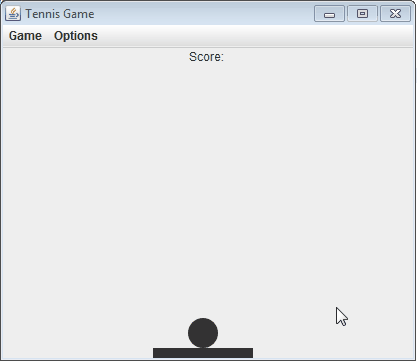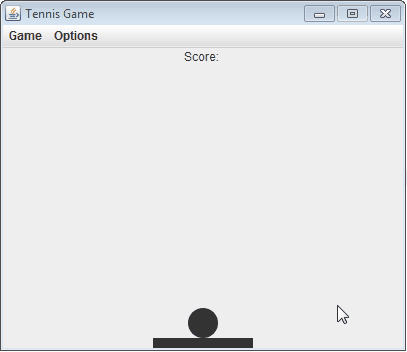I'm trying to create a breakout game, I've already done a lot of logic, but I've discovered an annoying problem regarding the size of the "scene" panel of the game.
Here is my class Board , which is the panel where all the components of the game are distributed:
import java.awt.*;
import java.awt.event.*;
import javax.swing.*;
class Board extends JPanel {
private static final long serialVersionUID = 1L;
public final int WIDTH = 400;
public final int HEIGHT = 300;
private final int UPDATE_INTERVAL = 20;
private Timer timer;
public Ball ball;
public Paddle paddle;
private JLabel scoreLabel, score;
public Board() {
paddle = new Paddle(this);
ball = new Ball(this);
setLayout(new FlowLayout(FlowLayout.CENTER, 0, 0));
scoreLabel = new JLabel("Score: ");
scoreLabel.setFont(getFont().deriveFont(12f));
score = new JLabel();
score.setFont(getFont().deriveFont(12f));
this.add(scoreLabel);
this.add(score);
this.addKeyListener(new KeyAdapter() {
@Override
public void keyPressed(KeyEvent e) {
paddle.keyPressed(e);
if (e.getKeyCode() == KeyEvent.VK_SPACE){
starGame();
}
}
@Override
public void keyReleased(KeyEvent e) {
paddle.keyReleased(e);
}
});
ActionListener action = new ActionListener() {
@Override
public void actionPerformed(ActionEvent arg0) {
updateBoard();
repaint();
}
};
timer = new Timer(UPDATE_INTERVAL, action);
setFocusable(true);
}
@Override
public Dimension getPreferredSize() {
return new Dimension(WIDTH, HEIGHT);
}
private void updateBoard() {
ball.move();
paddle.move();
repaint();
}
public void gameOver() {
JOptionPane.showMessageDialog(this, "Game Over");
newGame();
}
public void starGame() {
timer.start();
}
public void stop() {
timer.stop();
}
public void newGame() {
stop();
paddle = new Paddle(this);
ball = new Ball(this);
repaint();
}
public void setSpeed(int speed) {
ball.setSpeed(speed);
}
@Override
protected void paintComponent(Graphics g) {
super.paintComponent(g);
Graphics2D g2 = (Graphics2D) g;
g2.setRenderingHint(RenderingHints.KEY_ANTIALIASING, RenderingHints.VALUE_ANTIALIAS_ON);
ball.paint(g2);
paddle.paint(g2);
}
}
In the code above, it can be seen that I set width and height based on fixed values, and I overwritten the preferredSize() method to comply with these measures.
JPanel , but for some reason there is getting an additional space on the right, as can be seen by the collision of the ball and the bat in the right corner in the gif below:
Ithoughttheproblemmightberelatedto this other question , but extra space occurs within JPanel and has no relation to JFrame .
In the Ball class, the formula I'm using to detect the right corner boundary and reverse direction is in the move() method of both classes:
import java.awt.Graphics2D;
import java.awt.Rectangle;
public class Ball {
private int x = 0;
private int y = 15;
private final int DIAMETER = 30;
private int xSpeed = 1;
private int ySpeed = 1;
private final Board board;
private final Paddle paddle;
public Ball(Board board) {
this.board = board;
this.paddle = board.paddle;
y = paddle.getTopY() - DIAMETER;
x = board.WIDTH / 2 - DIAMETER / 2;
}
public void move() {
if (x >= board.WIDTH - DIAMETER || x <= 0) {
xSpeed = -xSpeed;
}
if (y < 15) {
ySpeed = -ySpeed;
}
if (y + DIAMETER > paddle.getTopY() + paddle.HEIGHT) {
board.gameOver();
}
if (collision()) {
float paddleCenter = paddle.getX() + (paddle.WIDTH/2);
float relativePos = (this.x + (DIAMETER/2) - paddleCenter) / (paddle.WIDTH/2);
if((relativePos > 0 && xSpeed < 0) || (relativePos < 0 && xSpeed > 0)){
xSpeed = -xSpeed;
}
ySpeed = -ySpeed;
y = paddle.getTopY() - DIAMETER;
}
x += xSpeed;
y += ySpeed;
}
[...]
}
Class Paddle :
import java.awt.Graphics2D;
import java.awt.Rectangle;
import java.awt.event.KeyEvent;
public class Paddle {
private int x = 0;
private final int topY;
public final int WIDTH = 100;
public final int HEIGHT = 10;
private int direction = 0;
private Board board;
public Paddle(Board board) {
this.board = board;
topY = board.HEIGHT;
x = board.WIDTH / 2 - WIDTH / 2;
}
public void move() {
if (x + direction >= 0 && x + direction <= board.WIDTH - WIDTH) {
x = x + direction;
}
}
public void paint(Graphics2D g2) {
g2.fillRect(x, topY, WIDTH, HEIGHT);
}
public void keyPressed(KeyEvent e) {
if (e.getKeyCode() == KeyEvent.VK_LEFT) {
direction = -5;
}
if (e.getKeyCode() == KeyEvent.VK_RIGHT) {
direction = 5;
}
}
public void keyReleased(KeyEvent e) {
direction = 0;
}
public Rectangle getBounds() {
return new Rectangle(x, topY, WIDTH, HEIGHT);
}
public int getTopY() {
return topY;
}
public int getX() {
return x;
}
}
How do I remove this space by keeping the size of the JPanel fixed?
As a testable example would look great in the question, I added in the Gist an executable code containing all classes ( Ball , Paddle and Board ) involved.








